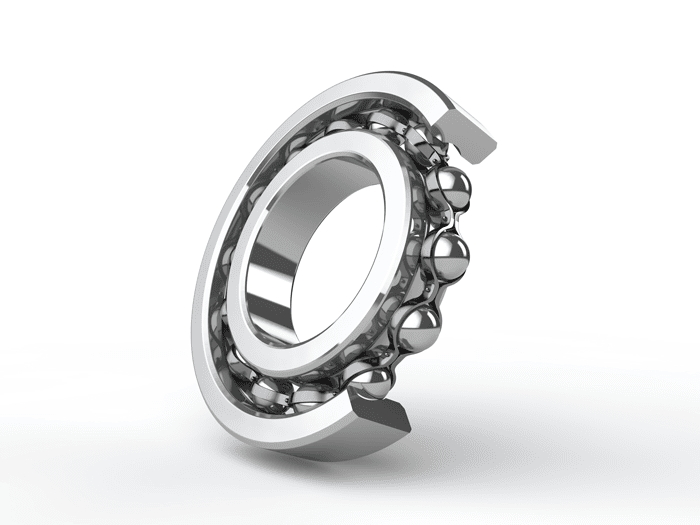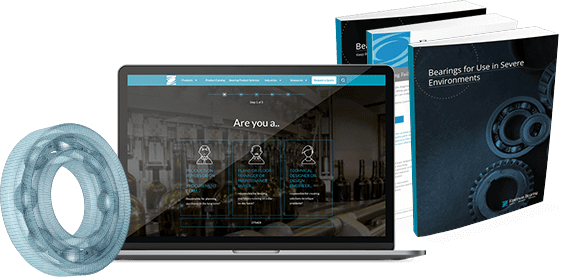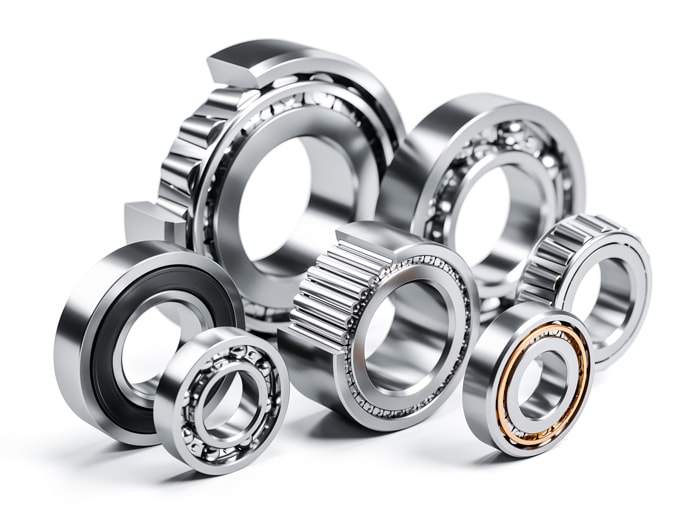Ball Bearings
For 50+ years, Emerson Bearing has developed and maintained a reputation for distributing high-quality roller and ball bearings, serving the needs of both international and domestic customers.
Our team of experts works hard to ensure every customer receives the bearing that best suits the demands of their specific application. We offer assistance with determining your needs while identifying any restrictions or requirements and supplying accurate pricing options and delivery schedules.
What are Ball Bearings?
Ball bearings consist of rolling elements that maintain separation between the inner and outer rings of the component. Using ball bearings reduces friction, allowing for a smooth, high-speed motion for sustaining axial and radial loads. Ball bearings can be developed for different speeds, loads, and applications.

Ball Bearing Material
The material used and the overall design features of a ball bearing can vary drastically depending on the application requirements. Commonly used materials include:
Multiple bearing rows, cages, and flanges are available as needed.
Ball Bearing Uses
Ball Screw Support
Ball screw support bearings prove beneficial in applications involving ball screws or lead screws. Most have angular contact for ball screw support with a steep angle contact often found in duplex, triplex, and quadruplex configurations.
Other ball bearing designs are available with separate thrust and radial roller bearings in a single assembly. Cartridge designs include the bearings, housing, and seal in one component.
Aggregate/ Concrete/Mining
Cylindrical or split spherical roller bearings are ideal for this mining, concrete, or aggregate applications to dramatically reduce downtime and maintenance costs. These types of ball bearings are especially useful in difficult-to-access locations.
For articulation/swivel joints, we recommend a combination of a maintenance-free spherical plain bearing used with a high load capacity four-point bearing.
Electric Motor Repair
Ball bearings are crucial in electric motor productivity. They perform the following essential functions:
- Minimize power loss
- Reduce friction
- Reduce noise
- Attain optimal design speed range
- Ensure long service life
Pump, Compressors, & Oil Field Industry
The most common ball bearings used in pumps for oil and gas industrial applications include the following:
- High-load capacity angular contact ball bearings with machined brass cages
- High-load capacity double-row angular contact ball bearings
- High-load capacity deep groove ball bearings
- High-load cylindrical roller bearings
Applications in Other Industries
A vast range of industries utilize ball bearings, which serve a wide variety of purposes in a broad range of processes. To learn more about the bearing applications, click here.
Industrial Ball Bearings from Emerson Bearing
Selecting the proper ball bearing is essential to ensure optimal reliability and performance for a specific application, with benefits that include:
Emerson Bearing is a leading distributor of rolling and ball bearings, offering a vast array of options for customers across many diverse industries. We are proud to supply products from industry-leading brands and have the largest inventory of bearings at multiple price points on the East Coast.
We are ready to help you select the bearings you need, and our technical team will work closely with you to ensure you get the proper component for your specific application.
Contact us today to learn more about our products and to discuss your specific needs with one of our trained experts. You can also request a quote and watch our video to learn more about our extensive product line.
Contact the Bearing Experts at Emerson Bearing Today
Bearings serve a key role in robotics and automation solutions. If you need high-quality bearings for your robotic or automation application, turn to the experts at Emerson Bearing. Equipped with over 50 years of experience serving the bearing needs of domestic and international customers, we have what it takes to help you identify the right bearing solution for your application.
For more information about our bearing solutions for robotic and automated systems, contact us today.
Special Solutions: Thin cross section, high capacity, ball bearings available in radial, angular, or four point contact styles. Off the shelf linear guidance for unique applications. Plain bearings (bushings) for small radial or axial design envelopes. These are maintenance-free and are available in metal backed style with a liner or thermoplastic with a composition to suit various needs: food grade, high load, dirty environment, etc.
Learn about bearings and their use.Check out our Technical Toolbox
for FREE downloads.

Technical Toolbox
View our library that includes our Nomenclature
Guide, Vendor Guides, eBooks and much more to
help with your next project! 

Bearing Failure Analysis
The accurate diagnosis of a bearing failure is imperative
to prevent repeated failures and their additional expenses.
This comprehensive guide to bearing failures outlines the
many ways bearings can and do fail. 

Industry Solutions and Bearing Resources
If you'd like to learn how bearings are being used in your
industry, check out our Industry Solutions page which has
dozens of eBooks, charts and data sheets. 
Browse our resource library!
Find custom product selectors, catalogs, CAD files,
eBooks, and more!
- Explore the library
or














